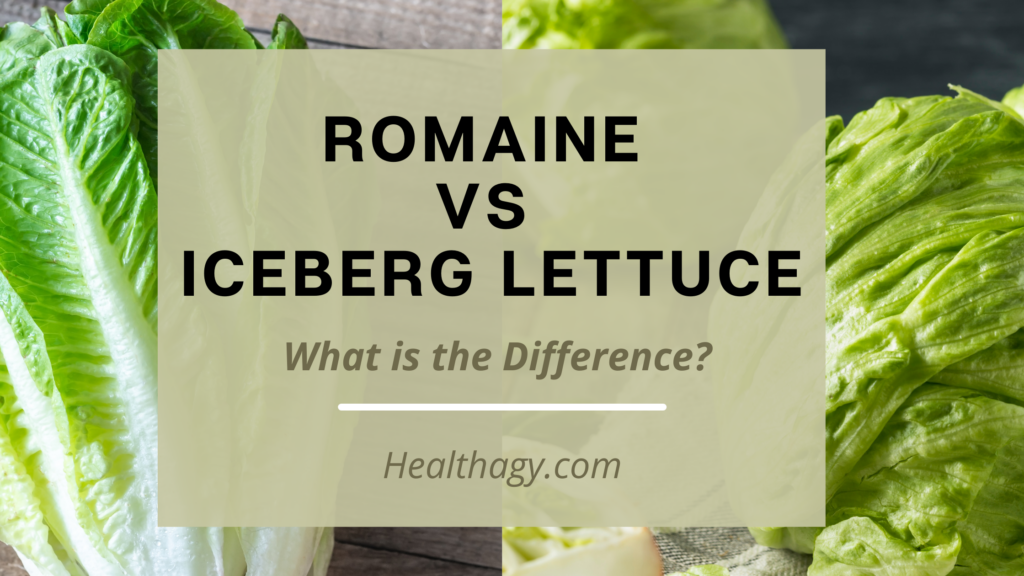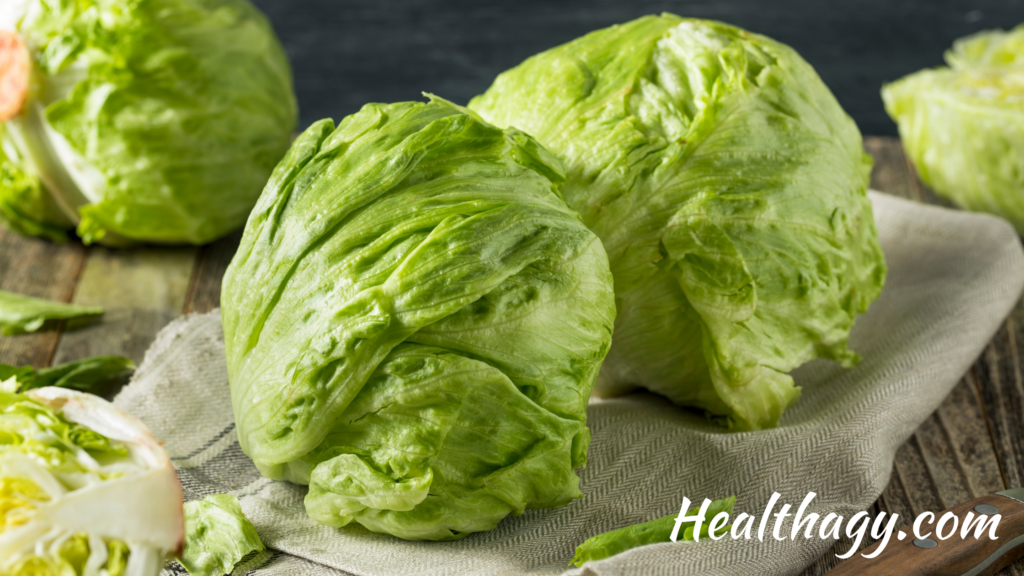
When it comes to making a salad, if you’re anything like me, you want to maximize the nutritional benefits of those yummy salad greens. Two of the most common, versatile, and popular leafy greens are romaine and iceberg lettuce. While they may seem similar in appearance with their crispy green leaves, they have many differences nutritionally. Keep reading to find out more and which gives you the most bang for your buck in nutritional value.
Key Differences Romaine vs Iceberg Lettuce
The biggest difference between romaine vs iceberg lettuce is that romaine lettuce is much higher in nutritional values across the board than iceberg lettuce. Most notably, romaine is a rich source of vitamin A, vitamin K, fiber, and iron. Romaine lettuce has a more robust flavor than iceberg, while iceberg is milder and sweeter in flavor.

Romaine Lettuce
Romaine lettuce is also known as cos lettuce. It is a popular salad green most commonly used in Caesar salads and many other salads. Romaine lettuce has crisp, crunchy leaves. It is easily found in grocery stores, sold as “hearts” or “heads” of romaine. Romaine is common lettuce used in restaurant salads as well.
Romaine is a very versatile green leafy vegetable. It makes a great salad base and goes well mixed in with other salad greens. Romaine can be eaten raw, cooked, grilled, used in stir fry’s, added to soups and smoothies, or used to top off a sandwich- or even in place of bread to hold a sandwich together.
Romaine Lettuce Taste
Overall, romaine has a mild flavor. The outer, darker green leaves of romaine have a grassier and bitter taste than the rest of the heart. Romaine hearts are the center leaves of the head of lettuce. They are sweeter, crispier, and lighter in color than the outer leaves, giving them the perfect texture and flavor for a crispy salad. Although the outer leaves are greener, softer, and more bitter, they provide great nutritional value.
When chopped up and mixed together in a salad, romaine salad will have a crunchier texture and mild green taste. Because romaine has a relatively mild flavor, it tastes great on its own or as a great addition to a variety of other leafy greens, vegetables, and compliments so many other dishes.
Romaine Lettuce Nutrition
Romaine lettuce is a rich source of vitamin A, vitamin K, fiber, iron, and several other vitamins and minerals. A salad containing about 2 cups of romaine provides you with nearly half of the recommended daily requirement of vitamin A and most of the vitamin K.
Romaine contains several other vitamins and minerals, but it’s important to keep in mind that a small side salad will still boast adequate levels of vitamin A and K, it will only have a minimal amount of these other vitamins and minerals. However, if you eat a good-sized meal salad, romaine can be a great source for nutrition providing several other vitamins and minerals such as magnesium, iron, potassium, and vitamin C.

Iceberg Lettuce
Iceberg lettuce is a common lettuce that grows in medium-sized balls or “heads” of lettuce. Iceberg lettuce leaves are tightly packed together and have high water content. It is very versatile lettuce, with many culinary uses from salads to garnishes for sandwiches to shredded for snacks.
Iceberg Lettuce Taste
Iceberg lettuce has a very crunchy texture, making it great for food prepping and leftovers. It stays crunchier longer and doesn’t get soggy as quickly as other lettuces. It has high water content, making it juicy with a mild and sweet flavor.
Iceberg Lettuce Nutrition
While iceberg lettuce is often thought of as having low nutritional value, it is a green vegetable and still has many benefits. It is actually a good source of vitamin K. Also, it contains folate and various other vitamins and minerals such as vitamin A, vitamin C, potassium, iron, calcium, and fiber.
Iceberg is also high in water content, helping to keep hydration levels up through a vegetable.
Is Romaine Lettuce or Iceberg Lettuce Healthier?
Known as a nutritious lettuce, romaine is superior to iceberg lettuce, particularly when it comes to vitamin A and vitamin K. Both romaine and iceberg contain many nutrients, but romaine blows the iceberg out of the field for its high vitamin A and K content. Vitamin A isbeneficial to eye health, helping to reduce the risk of macular degeneration. Vitamin K supports strengthening and maintaing healthy bones.
Besides its rich vitamin A and K content, romaine is also a great source of fiber and iron, containing nearly double the amount that iceberg does.
It also contains an adequate amount of folate and iron. Vitamin C helps boost the immune system and manage oxidative stress in the body. Folate supports cell growth. While iron is vital for red blood cells.
The darker green leaves provide the most nutritional value. However, the entire head is still full of nutrition.
Romaine vs Iceberg Taste
Although romaine and iceberg have similar tastes, especially when comparing them to other leafy vegetables like kale and spinach, they still have their differences.
Romaine has more of a bitter flavor, especially in the darker, outer leaves. In comparison, iceberg has a more mild sweetness to it.
Nutritional Comparison Between Romaine vs Iceberg Lettuce
Nutritional value for 100 grams of romaine lettuce vs 100 grams of iceberg lettuce.
This chart shows the % RDI (recommended dietary intake) daily values.
| Romaine Nutrition | Iceberg Nutrition | |
| Calories | 17 | 14 |
| Fiber | 2.1 gram or 8% | 1.2 grams or 4% |
| Protein | 1.2 grams 2% | 0.9 grams 2% |
| Calcium | 33 mg 3% | 18 mg 1% |
| Folate (vitamin B9) | 34% | 7.3% |
| Iron | 1 mg 5% | 0.4 mg 2% |
| Magnesium | 14 mg 3% | 7 mg 2% |
| Phosphorus | 30 mg 2% | 20 mg 2% |
| Potassium | 247 mg 5% | 141 mg 3% |
| Vitamin A, RAE | 48% | 3% |
| Vitamin C | 4 mg 4% | 2.8 mg 3% |
| Vitamin K | 85% | 14% |
| Zinc | 0.2 2% | 0.2 mg 1% |
Health Benefits of Romaine and Iceberg Lettuce
Both romaine and iceberg lettuce have numerous health benefits. While the health benefits will be much more significant with romaine as it is more nutrient-dense. In general, the darker the leafy green vegetable is, the more vitamin and mineral content it will have.
Romaine, in particular, is high in vitamin K although iceberg provides an adequate amount. Vitamin K is essential for maintaining strong, healthy bones and helps to reduce the risk of bone fracture.
Both romaine and iceberg have a high water content, making them an excellent source in keeping the body hydrated, mainly when eaten raw.
Romaine and lettuce are leafy green vegetables and contain various vitamins and minerals, contributing to overall greater health.
Leafy Greens and Gut Health
Leafy greens provide unique molecules that help support healthy bacteria in your gut. For some people with sensitive digestion or those recovering from digestive issues, raw lettuce may be hard to digest; try blanching them or lightly cooking them to see if this helps you digest them easier.
Best Lettuce Substitutes for Romaine and Iceberg Lettuces
With so many different types of lettuce to choose from in the grocery store, you may wonder what the best substitute for romaine is when the store is out of it.
Iceberg and romaine can easily be substituted for one another. Iceberg will be less flavorful and sweeter. Butterhead lettuce also known as butter lettuce (Boston or Bibb lettuce) will also work, these have softer leaves, but they are still flavorful. Green leaf lettuce and red leaf lettuce are great options too.
Key Takeaways
Adding green lettuce is a great addition to eating a healthy diet, the darker the leaves the more nutritious. While romaine lettuce has more nutritional value than iceberg lettuce, they are both versatile leafy greens that can be substituted for one another in salads and meals.
Karla Kueber is a Certified Evidence Based EFT Practioner and Health Coach, with a double Masters Degree in Education. She works with people to overcome emotional eating, curb cravings, and overcome resistance to eating new healthy foods. You can learn more about coaching with her here.